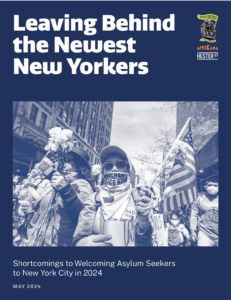As millions of people globally seek refuge from a range of adverse conditions in their countries of origin, New York City is facing an unprecedented influx of thousands of migrants. Over the past two years, nearly 183,000 asylum seekers have arrived in New York City amidst a political climate that limits migrants’ access to critical resources and social services through budget cuts, and creates additional barriers to securing asylum designation, housing, employment, and more. Beginning in February 2023, Hester Street (HST) collaborated with longtime partner Make the Road New York (MRNY) to design a borough-wide community survey in Queens to determine which outreach strategies best serve New York’s community of asylum seekers.
With the support of MRNY’s key organizing staff, Hester Street’s team distributed the survey to 766 asylum seekers and then collected and analyzed the data in order to create a preliminary report of survey responses released in June 2023. Immediately after the report’s publication, MRNY presented the preliminary survey results to the New York City Council to advocate for more resources for asylum seekers in the midst of a historic surge in migrants to New York City from border states.
The survey identifies gaps in access to basic resources and areas for improvement within existing support services. It also highlights the need for strategic and sustainable policy solutions that enable asylum seekers to build their lives in NYC and advance their communities. Our team collaborated with MRNY to produce “Displaced and Disconnected,“a final report on the results of the asylum survey, published in October 2023.
In February 2024, Hester Street, Make the Road NY, and Afrikana conducted a second survey of New York City’s migrants that identifies the challenges they encounter while navigating immigration services, and seeking access to housing, education, and labor and workforce development. Based on evidence of increased migration from regions outside of Latin America highlighted in our 2023 survey, we worked to expand our outreach and surveyed 121 African migrants, collecting 586 responses in total from migrants across backgrounds.
HST, MRNY, and Afrikana co-published “Leaving Behind the Newest New Yorkers,” a report based on the follow-up survey’s findings and analysis, in May 2024. Respondents from Venezuela represented 41% of participants who took the survey, followed by Guinea and Ecuador which contributed 36% of respondents (18% from each country), and Columbia and Peru, which respectively accounted for 9% and 3% of participants.
Key findings from the survey demonstrated asylum seekers’ substantial hurdles to securing basic services, work authorization, full-service legal representation, and longer-term shelter. Notably, only 60% of respondents surveyed had access to 3 full meals per day; 45% had access to warm clothing and reliable transportation. In comparison to results from the 2023 survey, fewer migrants are currently living in shelter, with a total decrease of 20%. Only 3% of respondents have been able to find steady work and almost none were able to land stable housing options after receiving a 30- or 60-day notice to leave shelter or reapply.
Based on the results of the report, we offer several local and federal policy recommendations to intervene and improve the landscape for migrants through New York City and the state at large. For New York City, HST, MRNY, and Afrikana call on local government to restore full Right to Shelter protections and expand temporary shelter options; create, fund, and sustain a Community Health Worker Project to reach migrants and other vulnerable communities with vital health services; limit the city’s cooperation with ICE; and expand work authorization for public jobs, among other critical suggestions. At the federal level, recommendations include expanding and renewing Temporary Protected Status (TPS) and Deferred Enforced Departure (DED) for countries affected by political unrest and natural disasters, expediting work authorization for asylum seekers, funneling more resources to New York’s asylum seekers, and reversing efforts to undermine the asylum system.


